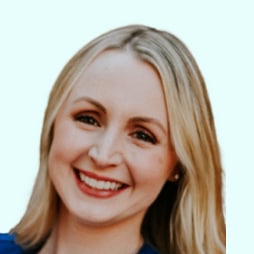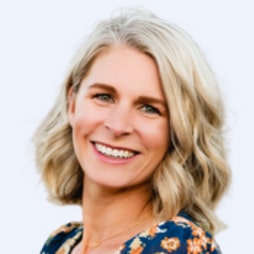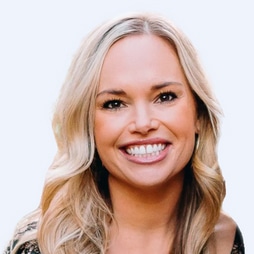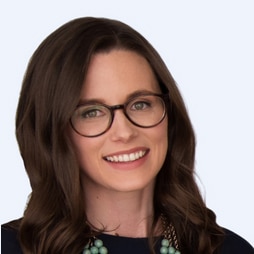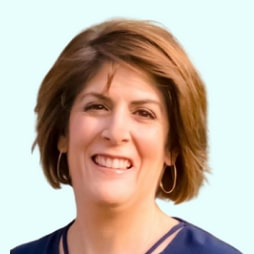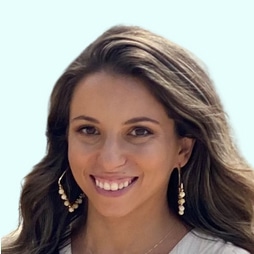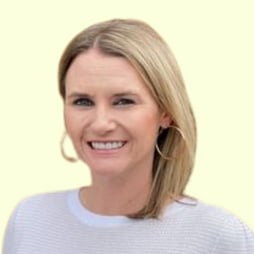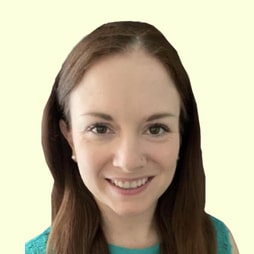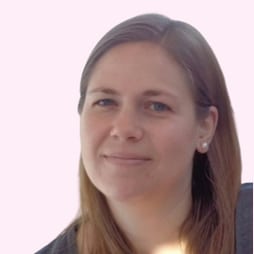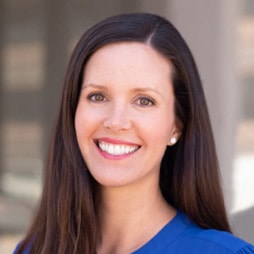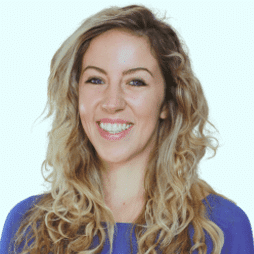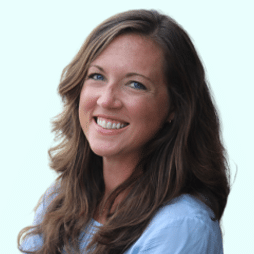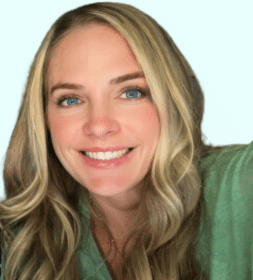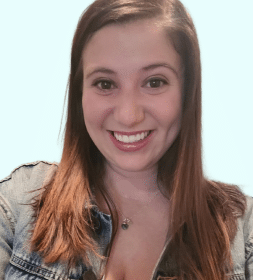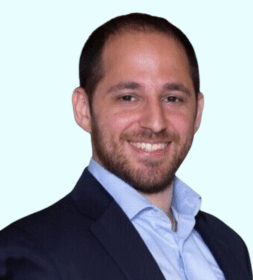You probably hear all the time that it’s important for advisors to be active on social media – but are advisors actually using social media to get new clients?
In this exclusive webinar, we’ll share four real-life case studies of top advisors that are using LinkedIn and Facebook to generate new leads. We’ll review how to market on social media by:
1 Employer
2 Demographic
3 Interest
4 Industry
Stick around until the end to receive your free gift. Register now to secure your spot!
Meet Your Webinar Host
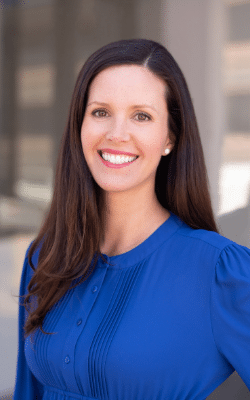
Claire Akin, MBA
Claire Akin runs Indigo Marketing Agency, a full-service marketing firm serving top independent financial advisors. She is a former Investment Advisor Representative and holds a Master’s Degree in Marketing. Claire works closely with several of Barron’s Top 100 Financial Advisors to grow their AUM using digital marketing.
READ THE TRANSCRIPT BELOW
Claire:
Hi, I’m Claire Akin with Indigo Marketing Agency and thank you for joining me for my exclusive webinar: How Four Top Advisors Are Marketing On Social Media. Now I know you hear all the time that it’s important for advisors to be on social media and that can get a little frustrating if you can’t envision how you would actually use social media to get new clients.
Today, we’re going to take a deep dive and show you four real life case studies of top advisors who are successfully marketing their business on social media. We’ll talk about marketing by industry, by employer, by demographic, and by interest. We’ll give you real life examples of exactly how advisors are using LinkedIn, Facebook, and Twitter to market their business and we’ll talk about how you can customize these strategies to fit your business.
Stick around til the end, because there’ll be a free gift. Thanks for joining us, let’s get started.
All right. So I’m going to move quickly and I’m going to try to give you as much information as I can and keep this presentation within 30 minutes because I know you guys are really busy and your time is really valuable. So let’s get started.
To tell you a little bit about my story, some of you know that I grew up in the industry. My dad’s an investment advisor representative and I started working with him in high school and then after college. Then after graduate school, I became an investment advisor representative myself and I have a Master’s Degree in Marketing. Through that process, I realized what I really love to do is marketing, so I still run the marketing department of his firm, but I also created Indigo Marketing Agency to allow advisors to outsource their marketing to somebody who knows all of the technical functions of marketing and create a cohesive marketing strategy and allow advisors to outsource that role of their firm.
Just to give you an update, if you’re on my email list, you know that I just had my first child, a little girl named Molly. She was born five weeks early. She had to stay in the hospital for 11 days, but she’s out now. She’s six weeks old and, as you can see, she’s particularly cute. I know I’m a little bit biased, but I sure think that she’s cute. Thank you for all of your best wishes and support during that time. I’m really happy that she’s doing great and she’s getting a lot bigger.
Today we’re going to cover a lot. First we’re going to talk about why you need social media and then we’re going to jump into four real life case studies of top advisors who are actually using social media to grow their businesses. Then we’re going to talk about how you can get started to do the same thing and I’ll give you a free gift at the end of the visitation.
Let’s talk about the difference 25 years makes. The top picture here is my wedding day when I was 30. You can see my dad there. Then the bottom picture is when I was five and I was an angel in the school Christmas play. You can see 25 years makes a big difference. I got a lot taller, my dad got a lot grayer, but what else happened in the past 25 years? Well, everything has changed.
This is a visual representation of the internet if it were mapped out, this is what it would actually look like. It’s changed the way that we do business, the way that we search for a restaurant. It’s changed everything, and it’s particularly changed for financial advisors, the way that we market our firms. Because of the internet and because of the rapidly changing communications industry, everything about how we market has changed and so we need to adapt.
Today, content is in the hands of consumers. If you look at somebody walking down the street, for better or for worse, their eyes and their ears are on their phone. We’re not looking up and interacting with each other as much as we used to. So if your business isn’t where consumers’ eyes and ears are, you’re really missing out. We want to be where the consumers are, and so that’s exactly what we’re going to talk about today.
The audience has really moved. A lot of advisors who I work with used to do seminar marketing in the past, and some of them still do, but today it’s really a difficult way to get prospects and it’s relatively expensive to some of the other alternatives that we’re going to talk about today that can be effective in getting qualified prospects and a little bit less expensive to get qualified prospects.
Why social media? Social media is so important today because you can find potential prospects, we can qualify your prospects and we can start the conversation. Instead of doing direct mailings to everybody in your zip code and inviting them to a dinner seminar, which could run you 10, 15000 per event, we can use social media marketing to get clicks to your website at about $1 per click. It has the potential to be a lot more cost effective for your marketing.
The other reason we want to use social media is because that’s where the consumers are. You can see across the world the percent of active accounts on social media across each country. In North America, we have 66% of people are on social media, which is incredible. Obviously, we’re leading the world and these numbers are just increasing.
You can see a lot of advisors that I speak with say, I get social media is big, but my clients aren’t on social media because they’re older. Well, that may have used to be the case, but today it’s just not the case anymore. You can see from this graphic that Facebook is huge and of people 50 to 64 years old, so those pre-retirees, 60% of them are on Facebook, even for people who are hopefully retired or getting close to retiring, 45% of them are on Facebook.
Today, so many people are on social media, even older people and retired people, and those getting close to retirement. The other reason that social media is important, it’s really a way of generating leads. You can see that 62% of people marketing on LinkedIn have actually generated leads on LinkedIn and 37% of people marketing on Facebook. That’s really what I’m going to focus on today is where can we actually generate leads? Well, LinkedIn and Facebook are the two key drivers of leads for professional services.
We’re going to talk about strategies using inbound marketing. I just want to give you a little bit of background if you’re not familiar with inbound marketing. Instead of advertising or outbound marketing, we use inbound marketing by helping people find you with great content. We create really educational valuable content that’s relevant to your prospects and we share it for free so that people can follow up and ask you a question or seek out your expertise. It’s all about using inbound marketing through the social media channels.
Content for inbound marketing has to earn attention because it has to be valuable, current, educational, entertaining and feel like a gift. What I mean by this is that the content that you’re putting out on social media is so valuable that people feel like they got it for free and they want to forward it to their friends or coworkers or family because it’s so valuable and they got it for free, it feels like a gift. When you’re creating your social media marketing strategy, I want you to really give away 90% of what you know and make the content as valuable as possible.
We want to answer your prospects’ most pressing questions. A lot of advisors have trouble coming up with relevant content. Think about the last five phone calls that you got or emails that are questions from your clients. Say you have a group of clients that you would love to replicate, you’d love to get more clients like them; what are the last five questions that they asked you? Are they asking about social security? Are they asking about their 401(k) plan? Are they asking about 1035 exchanges? This gives you some clues as to what your network is interested in and what’s relevant to them. Answer their most pressing questions with your content.
This is an example we did for my dad’s firm. We really work with a lot of widows and so for the steps to take one widow Google search, we created a piece of content that’s the first financial steps for widows to take. This is really relevant for our audience and it gets shared by our clients with their friends when they’re thinking about becoming widows or when they actually become widows, this is a great reference for them.
The goals of content marketing are to position you as the subject matter expert, to prompt specific questions and to start the conversation with your prospects. The same thing applies to content marketing on social media, it’s the same kind of mechanism to take your prospects from somebody who doesn’t know who you are to somebody who’s familiar with your expertise and wants to ask you a specific question that applies to them.
To do this, we really want to embrace the specialty. All of your marketing, especially social media marketing, is going to be ten times more effective if you have a specialty and that’s because it’s easier to find prospects of a specific specialty on social media and it’s easier to create content that resonates with them. We really want to drill down as far as possible into a niche or a specialty.
Answer the question, what one urgent problem do you solve for a specific group? I help independent financial advisors to market their firms using content marketing. What’s your one urgent problem that you solve for a specific group of people? That’s what we want to capture in your marketing campaigns.
You could have a specialization by industry, say you work with doctors or dentists or by employer. I have lots of clients who work with Intel employees or Chevron employees or employees of a large university, so that’s a great specialization. By interests. I have one client that works with equestrians or by demographics. Say you worked with widows or people approaching retirement, pre-retirees, or maybe Gen-Xers. These are all types of specializations that you could consider when you’re coming up with your specialty.
Here’s some real-life examples of specialties, just to give you some ideas. We help business owners find true wealth. This advisor is one of my favorite advisors, he helps business owners sell their businesses to find true wealth. What that means is take some chips off the table and get a greater work/life balance. They cash out of their business, which obviously creates a huge vestibule asset for him to invest on their behalf, but they’re able to find work/life balance, spend time with their family and find greater happiness.
A second example here is, I help LGBT Executives retire on time. This is an advisor in San Diego that does a great job with executives and that’s her niche. Faith-based financial planning for single women. That’s a real-life example for an advisor out in Texas. Helping dentists catch up for retirement in a hurry. Now this is a great way to kind of approach your dentists. Not only do you work with dentists, which a lot of advisors do, but you solve a specific problem for them. You help dentists who maybe have focused too much on the business or invested too much in their business and now they need to retire. You help them catch up for retirement in a hurry, using a variety of retirement savings vehicles.
These are all great specialty examples. I really encourage you, before you get started, marketing on social media, make sure you have your own specialty that is one sentence that people can articulate to their friends, family, and coworkers to refer you business.
Let’s talk about helping people find you when they need you most. This is at the heart of all of the campaigns we’re going to talk about today is you’re going to communicate your specialty through your social media marketing campaigns.
Let’s talk about our first case study. This advisor specializes by industry, like we discussed, and they use Facebook as a marketing channel. CRNA Financial Planning, they’re out in North Carolina. What they do is they serve certified registered nurse anesthetists who are relatively high earners. They’re similar to anesthesiologists, so they’re intelligent, high earners and this advisor’s wife happens to be a CRNA and so that’s all they do. They focus on comprehensive financial planning for CRNAs.
You can see an independent financial planning firm serving CRNA professionals. This is such a fantastic specialization that this advisor has fully embraced. You don’t see his website saying that he does comprehensive wealth management, but some small tab within his website says planning for CRNAs. Nope. His entire logo brand, everything, embraces his niche and that’s part of why he’s so successful.
They also have a lot of content that pertains to CRNAs. This is his book that he published on Amazon about The Wealthy CRNA. It’s a financial planning book for CRNAs and it actually provides CE credit for their certification body. This is such a great example of a way that when you do embrace a niche, you can create content that really appeals to your niche and is valuable. Not only do they learn everything that they learned from reading the book, but they also get CE credits so that’s an amazing marketing idea there.
What we did to market his firm on Facebook is we created this digital download. We created this CRNA Investor’s Guide: Avoiding the Three Biggest Mistakes. We talked about the three biggest mistakes that retiring CRNAs make, how to avoid those, and kind of the solution. Then we marketed this using Facebook. This is another report that we actually used on Facebook as well. This is how to prepare for the rise of anesthesiologist assistants. This is something that pertains to their industry. It’s something that a lot of CRNAs are thinking about, they’re worried about, and so it’s a very hot topic for them. We use this in one of our Facebook ads.
Here’s an infographic that we created for a Facebook ad and so this is the 2017 CRNA annual salaries. It’s really interesting. These people are high earners but it varies a lot by state. You can see the highest salary is about 250000 in Montana, whereas in Arizona, CRNAs only make 120000. This was really interesting. This got thousands of views, like almost 3000 views on Facebook from CRNAs. Can you imagine if you could get 3000 qualified prospects to click on your website from Facebook? Well, that’s what happens if you really embrace a niche and put out content like this that’s uniquely interesting to them.
So you can see, this is an image from Google Analytics that shows their monthly sessions from social media. You can see that 91% of their social media traffic is coming from Facebook. We’ve got about 842 sessions in an average month from Facebook for CRNA Financial Planning. This is what you want to look like if you’re not sure where to focus your efforts on social media, I can show you how to look at Google Analytics to see where your traffic is coming from and this could be a dead giveaway where Facebook is obviously going to be my key driver, that’s where I want to focus.
What we did here to market on Facebook is we created this infographic and then we created a lucid post. What that means on Facebook is we’re paying to have Facebook expose our content to people that we select via Facebook targeting. We selected CRNAs in North Carolina. We created the ad, and you can see the ad right here. Then we boosted it for just $30. Not very much gives you a lot of exposure. Then we shared it and the call to action, once they click on the link of the Facebook ad here, they get a call to action to download the report. They have to enter their email address to actually download the report. Then we can follow up with those leads. They’re entered into an email workflow where they’re introduced to the firm. We walk them through the background of the firm, what the firm does, how they help clients and how they can actually schedule an appointment to learn more.
You want to create your Facebook ad, boost it and then have it convert with a call to action. That’s a little mechanism for Facebook.
Let’s talk about another case study using LinkedIn. This case study uses specialization by employer, which is one of my very favorite ways to specialize. It’s very effective on LinkedIn. It’s kind of a no brainer for advisors who work with a lot of employees of a certain company.
For this advisor, they are up in Wisconsin and they are in kind of a small town. There’s one large employer in the town that they wanted to focus on. We focused on Greenheck, which is the local employer and it employs a lot of people in their demographic.
The report we created was, How to Maximize Your Greenheck Benefits Package, and here’s the page on their website where people can enter their name, phone number, and email address to download that report. It’s really valuable. It covers everything from their health savings account to their 401(k) plan and a lot of interesting tips to get the most out of the benefits.
Here’s the download page. What we did is we used LinkedIn to direct people to this page where they can opt in to download the report and learn more. Once they read the report, they oftentimes have questions for the advisor about how they can maximize their own benefits package or their specific 401(k) questions or what have you.
Here’s what the report looks like. You can see it’s designed with the employer in mind. The people who work at this company are engineers and you can see that we’re designing it not from a perspective of the wealth management firm, but from the perspective of employees of this company.
What we did is a LinkedIn customs search for people who work at Greenheck Fan Corporation. You can see there’s hundreds of them. We went ahead and sent them the report with a LinkedIn direct message. Here is the actual message that we used:
Hi, Thomas, thanks for accepting my connection request. I’m an independent financial advisor that helps Greenheck employees prepare for a secure retirement. My firm specializes in the Greenheck’s benefits package. We recently released a port on “How to Maximize Your Greenheck Benefits Package” that I’m happy to share. Do you need help navigating a retirement plan or your benefits?
Then there’s a link to that landing page and his contact info. We sent hundreds of these out and directed people to the landing page. You can see, we got a lot of nice responses like, “Hey, let’s discuss during my meeting. I actually work in compensation and benefits at Greenheck, so it’s a great starting point.” Then we received a lot of other responses from people who had questions or who really appreciated the report and wanted to learn more about point wealth.
Then, since we had their email address through this campaign, we were able to send some follow-up email promotions like this one, Greenheck Employees Save 50% on a Retirement Plan. This way we can try to convert more of those leads because they opt in and we have their email address so we can send this campaign and follow up emails.
Let’s talk about our third case study. This is specialization by interest. For this advisor we used Facebook to connect with his prospects. This is 1 On 1 Financial and they’re out of Irvine, California. What they do is they do lot of cycling. The founder of the firm is a big cyclist. He does road biking, he also does mountain biking. He’s in several cycling groups and so he’s known throughout the cycling community. He’s very well known. So we used cycling through their marketing to connect with people who he shares an interest with.
He had these great videos created. He had a road bike video that talks about how he does his financial planning process and how it relates to road biking. Then a really awesome mountain bike video that’s very similar about how financial planning is similar to mountain biking. These were really well done videos. They resonate with people who are into mountain biking or road biking and it just makes him likable and very trustworthy to somebody because they share his interests and people who cycle kind of have things in common and they can relate to one another. This is a great way that he was able to connect with prospects on Facebook.
You can see even his LinkedIn profile has a mountain bike tire behind him. I thought that was really a nice touch.
On Facebook, we did boosted posts where we share these great videos and people click on them and it tells a little bit about the founder and it also tells a little bit about the firm. That’s a great way to use a video on Facebook, boost it post to get a lot of traffic to get people to become familiar with you, but also to become aware of what they have in common with you. The strategy was really successful for him.
We also did a campaign for the cycling group that he’s a part of that has several hundred members in Orange County. We did a Facebook campaign of an exclusive financial offer for members of this cycling group and that got him a lot of leads. We used the video as bait and we said that they can save 50% on a financial plan and they have a free introductory consultation. Creating some of these offers for people who belong to this niche was really successful and then sharing those on Facebook.
For our fourth case study, it’s a little bit different. We used LinkedIn as the marketing channel. We specialize by demographics, but we also went a step further and we did a Center of Influence campaign. Instead of reaching out directly to people who belong to the demographic target for this advisor, we reached out to centers of influence who served the same demographic. I’ll show you what I mean.
Engaging Women in Wealth is located in Rancho Santa Fe, California. It’s a wealthy suburb of San Diego. This advisor serves only women. You can see throughout the website, their specialty is very well captured. Their clients are women, usually divorced or widowed or single women and that’s who they serve and it’s communicated very clearly throughout all of their marketing strategy.
You can see this brochure that we sent. It talks about her story. It talks about the awards that she’s won, the book that she’s written and exactly what she does for clients and how she helps them. This was a great piece that we created so that she could share this with Centers of Influence and so that they could share it with their clients.
It’s one thing to have Center of Influence say, oh, you need a wealth advisor? Well, let me give you this person’s name and phone number. We want them to go a step further. Let me give you this PDF download that tells her story. It tells why she does what she does. It gives her some credibility with all these awards and this book that she’s written. This is a nice asset to give to Centers of Influence so that they can refer you more effectively.
What we did is we connected with Centers of Influence doing a LinkedIn search for Rancho Santa Fe, and connecting with all of the CPAs, attorneys, realtors, mortgage brokers, elder care professionals, community leaders who live in her community. Then we just sent a message just introducing her letting them know who she is, what she does and how she can help. Here’s the message:
Hi, I’m an independent financial advisor in Rancho Santa Fe serving women and divorced women who are concerned with having too much risk in their portfolios. From reviewing your profile, it looks like we may have some clients who overlap. Are you available for a 10 to 15 minute phone call to learn more about how we can collaborate professionally?
The goal is to start a conversation with these Centers of Influence, and make them aware of her so that when they come across someone who needs her help, it’s easy for them to refer business and she can refer business back to them. She can learn more about what they do, who they serve and what makes them different.
From this LinkedIn campaign, we sent 100 outbound connection requests. We got 27 new connections, people who accepted her connection request. We sent an outbound direct message to all of those new connections. Six of them elected to set up a phone call and she got two new referral relationships out of this particular campaign. We can repeat this every single month and over time, she’ll build her new referral relationships where we want every CPA or every estate planning attorney in her town to know exactly who she is and to be able to refer business to her when they come across clients who need financial planning help.
As you can see, these are four great examples of real life advisors who are actually using social media to market, but of course, you’re going to want to customize your strategy for your specialty and for the social media channels that work for you. It’s important to customize the strategy for what works best for your firm. You may even want to try out a few different strategies, maybe try LinkedIn Strategy, maybe try Facebook strategy and see which works best for you.
To learn more, there’s a few resources for you. First of all, the LinkedIn Guide for Financial Advisors is on Amazon. This is imperative if you’re going to embark on any LinkedIn campaign. This will tell you everything that you need to know, from creating your LinkedIn profile to prospecting on LinkedIn, to sending direct messages. That’s a great resource, it’s on Amazon now.
The LinkedIn Course for Financial Advisors is available on my website. This is an online self-study course that it really takes a deeper dive and walks you through exactly how to do all of these marketing campaigns on LinkedIn.
And you need to check out more exclusive webinars by signing up for my newsletter, indigomarketingagency.com/newsletter.
I want to take a little bit of time right now to give you your free gift. Thank you for watching til the end of the webinar to get a chance at taking a free trial of the LinkedIn Course for Financial Advisors. You can sign up for the free course by going to the indigomarketingagency.com/free course, and for a limited time, I think it’s 30 days, you can take the LinkedIn Course for Financial Advisors for free. That will walk you through everything that you’ve ever wanted to know about LinkedIn. It’s really action packed and it shows lots of examples and there’s lots of downloadable resources, templates, and examples that you can use to start your own LinkedIn marketing campaigns.
Please take this time to connect with me on LinkedIn. Go to LinkedIn.com/in/claireakin and that way we can stay in touch there, and ask a question any time about this webinar or any marketing questions that you may have [email protected]. Thank you so much for watching the webinar. Let me know if you have any questions and I look forward to speaking with you soon.
CONTACT US
- 9437 S Santa Monica Blvd #207 Beverly Hills, CA 90210
- (619) 786-7787
Join our newsletter

Book A Call
Schedule Your FREE
Marketing strategy Call Now
- What your business has done in the past
- What is working for you and what is not
- How your marketing compares to top advisors
- Our custom recommendations for improving your marketing today
Introducing The New
Total Marketing Package
Now with tiers!
- Stand out in a competitive market
- Generate quality leads
- Make your marketing efforts more effective

GET $1000 OFF when you book your call today. Only until 4/30/2024
Anne Wheeler is responsible for a variety of administrative tasks as well as updating social media pages for clients. Anne enjoys the creative side of her position and the ability to collaborate with the team to help advisors get started with Indigo.
Anne holds a bachelor’s degree in communication from the University of Tennessee. Outside of work, she enjoys walking, baking, spending time with her husband, Rick (a structural engineer), and two sons, Thomas and Turner. Anne loves being a full-time mom, and appreciates that Indigo gives her the opportunity to work part-time while still caring for her boys.
Leading the Indigo team with heart, Hugo Fernandez is passionate about helping our financial advisors attract a flood of their A+ clients with sustainable marketing campaigns. He enjoys running companies that are wildly successful and wearing a black t-shirt every day of his life. When his two favorite things come together, you have an average day at Indigo.
Hugo Fernandez is also CEO of Indigo’s partner company, Just Digital, and author of The Client Acquisition Blueprint. He has personally helped hundreds of entrepreneurs grow their business through his proven blueprint for creating an EPIC marketing strategy and online presence.
Kelli McLeod plays an integral role at Indigo while overseeing the Account Services Team, providing customer service, getting financial advisors onboarded and in serving as their primary point of contact during that process. Her team looks to her for her leadership and decision-making abilities For Kelli, the most rewarding part of this role is working with clients one-on-one to ensure they’re happy and that their needs are met.
Kelli has a bachelor’s degree in communications and public relations from Pacific Lutheran University. More recently, she’s done extensive work in the corporate housing and property management industries.
Kelli currently lives in Colorado Springs, Colorado, with her husband, Ian, who is an officer in the U.S. Army, and their two sons, Zachary and Cameron. When she’s not working, you can find her running or hiking, attending group fitness classes, and cooking. Kelli’s also an avid book club enthusiast, so be sure to reach out to her if you’re looking for a new read.
Sara Dressler manages all systems and operating processes while overseeing several departments. Sara is responsible for supervising many activities within Indigo and identifying areas of improvement to better meet company goals. She functions as the bridge connecting management to every department.
Sara has a bachelor’s degree in business administration and a minor in communications from Pacific Lutheran University. She leverages this degree, along with her years of experience as a virtual assistant, to keep our company running like a well-oiled machine. Sara is happiest when spending time with her family. Her three young boys and life as a military spouse keep her busy, but she wouldn’t trade it for the world. She lives an active lifestyle and loves working out, getting outside, and watching sports with her family (whether it’s on TV, at her kids’ games, or in the backyard).
Elizabeth Reider is a woman of many talents. She spent 10 years as a Chief Marketing Officer for a top-level independent financial advisor, and since her entry into financial services, she has networked and become friends with many advisors. Elizabeth admires their empathy, knowledge, and passion for their work, and has seen how independent advisors are more than professionals providing investment and planning advice; they are trusted confidants, life coaches, and guides. Over time, they become a part of their clients’ extended family—and she loves coming alongside that. (Check out this video to hear directly from Elizabeth about why she loves working with financial advisors.)
As Director of Marketing, Elizabeth helps get the word out about how partnering with Indigo can take an advisor’s marketing to the next level and beyond to grow their business and increase their productivity.
Elizabeth earned her bachelor’s degree in management information systems from the University of South Florida Muma College of Business. She also holds a life, health, and variable annuity license, which gives her a special understanding of the many products and services advisors offer. Originally from Clearwater, FL, Elizabeth loves to travel and has visited 12 countries, including extended visits to eSwatini, Africa, to visit family and assist with humanitarian relief programs. She has seen firsthand how independent financial advisors are providing advice to their clients that outpours into the lives of their own families, staff, community, and sometimes across the globe. When she’s not working, Elizabeth enjoys attending orchestral and theater productions with her husband, David, and taking their son, Julian, to art museums, as well as family evenings in the backyard playing baseball with her son and shih-tzu poodle, Wrigley. She is also an active participant in overseas humanitarian work—using her skills to make a difference in the lives of others.
It’s Katie Cress’s mission to help financial advisors reach their ideal prospects through custom digital marketing. On any given day, you can find Katie meeting with new financial advisors to learn more about their marketing goals, who they love working with, and why they’re passionate about helping others. Her favorite part of her job is meeting new advisors every day and continuing to learn how each firm and individual advisor is different, and using her marketing and small business background to help them craft a game plan that empowers them to grow their business and enhance their services. Often described by loved ones as a “helper” and “caretaker,” Katie is passionate about advocating for her advisors’ needs and supporting her coworkers to help them succeed.
Katie holds an MBA from Xavier University and a BA in Economics from Ohio University. A Midwest girl for life, she lives in Cincinnati, Ohio, with her husband, Brandon (who’s also a marketing guru), and their three kids, Charli, Lucy, and Teddy. She and her husband also own Clean Eatz Cafe, where they use their collective marketing prowess and love of food to create a welcoming space for employees and hungry customers alike. Katie is passionate about and for small business owners, being raised by her father who was an entrepreneur, being one herself with her husband, and working with them every day at Indigo. She loves the spirit, creativity, and drive of entrepreneurs. When Katie’s not working or helping run the family business, she enjoys working out with her husband at Orange Theory, loving on her three kids, and cooking delicious food.
Lori Koepke plays a major role as a liaison between Indigo Marketing Agency and its wonderful clients. She works directly with our advisor clients on their marketing strategies, marketing calendars, article creation, editing processes, compliance approvals, deployment of their content, and more. Lori enjoys helping strategize and be a support to her clients, and loves the camaraderie among the Indigo team members.
Before joining the Indigo team, Lori was a schoolteacher for 10 years. She has a Master of Education and Bachelor of Arts in Elementary Education from Concordia University in Portland, OR. She was born and raised in Vancouver, B.C., and lived in Vancouver, WA, for 25 years before moving to Boise, Idaho, where she currently resides with her husband, Jeremy, and four wonderful kids, Sophie, Tanner, Jonas, and Violet. In her free time, you can find Lori reading, watching football, and driving her kids to all their activities.
Watch this video to hear why Lori loves working with Indigo.
Heidi Wilson thrives on helping advisors create an online voice and streamline their marketing efforts. With her mother being a retired financial advisor and her brother-in-law currently a CFP® professional, she’s passionate about taking the marketing pressure off of advisors so they are able to focus on their clients. She loves when advisors tell her something we did for them helped; it can be as simple as taking something off their very busy plate or helping them land a new client with one of the articles we wrote. With broad-based consumer and B2B marketing experience, Heidi is constantly thinking outside the box and brings a fresh perspective to the Indigo team.
Heidi holds a bachelor’s degree in public relations from Florida State University and hails from Tampa, Florida. Her husband, Chris, is in the U.S. Army, and as they are constantly moving, they take every opportunity to explore the new areas where they’re living. Some of their favorite places they’ve called home include Hawaii and New Orleans. Heidi is thankful for the opportunity to work remotely with Indigo, which allows her to take her job with her, no matter where the Army moves her family next.
Watch this video to hear why Heidi loves working with Indigo.
Jillian Segrue acts as a liaison between clients and the Indigo team, using her 12 years of customer service experience in fields such as healthcare, financial services, and risk management to help hone their message and deploy it effectively and efficiently. Jillian enjoys building unique relationships with each of her clients as she uniquely helps them reach their ideal target audience.
Jillian has a bachelor’s degree in healthcare administration and a minor in business administration from SUNY Brockport. Originally from Rochester, NY, she currently lives in Columbus, GA, with her husband, Tim (an Army captain), daughter, Macie, son, Henry, and two cats. As a military spouse, Jillian appreciates the flexibility Indigo provides—allowing her to juggle motherhood and excelling in her career—and its unmatched positive, supportive, and uplifting company culture. In her free time, Jillian loves to read, shop, and go running outdoors (just not in the Georgia heat!).
Amanda Laskey works with clients one-on-one to develop and implement marketing strategies that help spread the word about who they are and how they help. In her role, Amanda strives to deliver outstanding customer service to our clients. She is tech-savvy, an independent problem-solver, extremely organized, an excellent communicator, and thrives on helping others. She appreciates the ability to work remotely in a collaborative team environment while supporting her family.
Amanda holds a Bachelor of Arts in Education and a Master of Arts in Inclusive Education from Seton Hill University and has over 10 years of experience in secondary classroom teaching and over 3 years as an Executive Assistant. A proud Army spouse, Amanda resides in Pittsburgh, PA, with her husband, Brandon, their two sons, Jackson and Harrison, and their sheepadoodle, Waylon, and goldendoodle, Cash. Outside of work, Amanda enjoys spending time with her family, relaxing at the beach, traveling to new places, dessert, and all things Disney.
Beverly Anderson is the go-to contact point for advisors to create a targeted and cohesive marketing strategy that is unique to their specific goals. She loves seeing her clients experience positive results from their marketing efforts, and as a world traveler, she appreciates the ability to work remotely and connect with clients from any country.
Beverly holds a Bachelor of Science in Business Administration from Oregon State University. In addition to traveling, she enjoys making music as a singer/songwriter and anything outdoors (she’s an avid snowboarder and rock climber). She and her partner have a rescue pup, Toro, a former street dog in Cabo, Mexico, before they adopted him. Beverly has three older sisters, with whom she is very close, and they all, along with her mother, live in the Portland area. Although she spent the first half of her childhood in Fountain Hills, Arizona, Beverly considers Portland to be home.
Watch this video to hear why Beverly loves working with Indigo.
Kasey Yhap’s commitment to her clients is the driving force behind her work. Her diverse educational background (a bachelor’s and master’s degree in vocal performance from the Peabody Conservatory of Music and a master’s degree in communications from Syracuse University) has equipped her with the unique skill set required for success. Kasey’s strong communication skills and creative mindset, combined with her passion for helping her clients, make her a valuable asset to the team.
In her free time, Kasey stays active and maintains a healthy lifestyle through yoga, CrossFit, and spending time outdoors. These hobbies complement her professional life by allowing her to recharge and bring new ideas to her work at Indigo.
Dan Corcoran enjoys being on the front lines of financial advisor marketing, working directly with advisors to help them build a strong marketing plan to get their firm’s message out. Working remotely can be a challenge as talking to others, brainstorming, and sharing experiences recharges him; he maximizes touchpoints to connect with others to make every day at Indigo rewarding.
Dan holds a bachelor’s degree in journalism and mass communication from the University of Wisconsin-Madison. He enjoys drone photography and videography (he owns his own drone business, Forward Focus Photography), sports broadcasting (he was a hockey broadcaster for four years prior to COVID), spending time with family, camping/hiking, running, swimming, and road biking.
Originally from Sun Prairie, WI, Dan has three siblings, and prior to joining Indigo’s team, he worked for an RIA in Madison for two years.
Lisa Gaines spends her work days uploading blog posts to our clients’ websites and LinkedIn profiles, drafting emails, and making adjustments to content as advisors request. Lisa has learned a lot as a long-time member of the Indigo family and has enjoyed seeing the processes evolve to become more streamlined and efficient over time. And she loves working with the amazing Indigo team!
Lisa is a proud alum of Texas A&M University, where she received a Bachelor of Business Administration in Finance. As a military child, Lisa feels as though she grew up everywhere; however, she claims central Texas as home where most of her family is originally from. She currently lives in Fort Hood, Texas, with her husband, Korey (an active-duty Army officer), and two kids, Madelyne and Jameson. As a military family, Lisa moves quite a bit—often to areas where the job market is small. She loves that Indigo provides her with a steady job she can take with her wherever she goes. When she’s not working, Lisa enjoys dabbling in interior design, binging a good Netflix series, and spending time with friends and family.
Read more about why Lisa loves working with Indigo.
Joshua spends his days developing client websites, implementing automations, and troubleshooting website issues. He enjoys the challenge of working with websites while simultaneously learning new tips and tricks to optimize them for maximum efficiency.
Originally from Pulupandan, Negros Occidental, Philippines, Joshua holds a Bachelor of Science in Information Technology, and in his free time enjoys playing computer games and watching anime and movies.
Jennifer Farrior is Indigo’s go-to for all things proofreading and editing. Her attention to detail is unmatched, and she takes pride in making sure every article is clean and concise before it heads out to our financial advisors. She says, “Even a single typo can affect an advisor’s credibility, and we strive for perfection when it comes to how they’re presented online.” As Lead Writer, Jennifer trains and manages the team of writers, and also writes and collaborates with team members to create Indigo’s blog posts and promotional material.
Jennifer holds a bachelor’s degree in English from UCLA. In addition to her role at Indigo, she runs her own copy editing and proofreading business, She Proofreads LLC. Jennifer hails from San Diego, California, but now lives in Louisville, Kentucky, with her three kids, Joshua, Julia, and Joel, and goldendoodle, Dexter. She loves working at Indigo because it provides her with the income, flexibility, and the community she needs as a stay-at-home mom. Outside of work, you can find her spending time with her kids, friends, boyfriend, or working on a puzzle while watching Netflix.
Sarah Robichaud uses her love of spreadsheets to create engaging content calendars for our clients’ social media pages. Sarah holds a bachelor’s degree in psychology from Salisbury University and a master’s degree in marriage and family counseling from Liberty University. In addition to her role at Indigo, Sarah volunteers as a virtual administrator for Army Wife Network, a nonprofit organization that aims to empower and educate military spouses through blogs, podcasts, and various other resources.
Born and raised in Maryland, Sarah currently lives in Rochester Hills, Michigan, with her husband, Andrew, two children, Emily and Logan, and two fur babies, Penny and Chewbacca. As a military spouse and mother, Sarah loves working for Indigo because of the flexibility it affords her, allowing her to continue to build her career while frequently relocating around the globe and working on her own schedule to accommodate a busy lifestyle. Sarah also loves Indigo’s supportive team atmosphere. Outside of work and volunteering, you can find Sarah enjoying time outdoors with her family, typically running, camping, or traveling. An avid traveler, she’s visited 16 countries and is always planning her family’s next great adventure.
As a natural problem-solver, Peter Wardenaar uses his skills to help financial advisors find new ways to grow their site traffic and attract more clients they love. Peter enjoys the dynamic nature of his role; the challenges are never the same as every situation is unique and requires a different approach. But don’t let Peter’s technical prowess fool you—he also has quite the creative side! Before joining the Indigo team, he worked as a first-grade teacher and university English professor in Cali, Colombia.
Peter has bachelor’s degrees in education and in music from Portland Bible College and a master’s degree in music production and technology from Berklee College of Music. In his spare time, he loves writing and recording music, graphic design, engaging with people, and studying leadership and theology. Peter is also one of the most well-traveled people you’ll ever meet! He was born and raised in the Netherlands but lived in the Pacific Northwest for over 12 years. Today, he resides in Cali, Colombia, with his wife, Gloria Isabel, and their three kids, Emanuel, Paloma, and Violet.
Kourtney Kearney is a data-driven woman with a knack for coding. On any typical day, you can find her building web pages, troubleshooting bugs in code, and setting up automations to make life easier for our clients. Thanks to her technical background, Kourtney has a vast understanding of the inner workings of websites and the data associated with them. She’s always on the lookout for new technology that will help us improve our workflows so we can focus on what we do best—helping financial advisors grow their business. Kourtney enjoys the variation of tasks and loves the challenge of taking an existing website and making it better without completely rebuilding it.
Kourtney is originally from Newark, CA (Bay Area), but currently resides in Antelope, a suburb of Sacramento, and holds a Bachelor of Arts in Art History and Curatorial Studies. Outside of work, Kourtney spends her free time reading, playing volleyball, baking with her two sons, and hanging out with family.
Adrian Bachini works on tasks requiring technical knowledge and other various administrative tasks. A software developer by day, prior to joining Indigo, Adrian had very little knowledge on how nontechnical positions operate. His position at Indigo allows him to both learn and experience a variety of platforms and gain more knowledge about how to maximize marketing initiatives.
Adrian holds a bachelor’s degree in computer science with a specialization in software technology from De La Salle University Manila. Adrian considers himself somewhat of a workaholic, with a full-time day job in addition to working with Indigo. When he’s not working, he enjoys watching documentaries, action movies, and anime, and also loves cycling on muddy downhill trails or cross-country rides, playing video games, and simply resting when he can. He is also a licensed commercial pilot and flies in his free time; he obviously also enjoys traveling. Adrian lives with his family and more than a few pets (11 dogs, 6 cats, a few birds, and fish)—he has more pets than humans in his home!
Adriana Escalante thrives on creating an online representation that looks and feels true to our financial advisor clients as she builds their websites to best represent them and their businesses. Her experience working on travel and tourism websites motivates her to make sure every site she works on is exciting and engaging to web visitors. A graduate of University of Texas in Austin, Adriana double-majored in International Relations and a Liberal Arts program called Plan II. She also received a certification for front-end development from a coding academy in Austin, which has equipped her to serve as a great liaison between developers and clients.
After living in Austin, TX, for most of her adult life, Adriana now resides in San Antonio, TX (a city with a ton of history and many things to do), with her partner, Russell, and their dog, Abbey. She also has a brother and sister with whom she’s very close and tries to see a few times a year. Most of Adriana’s hobbies revolve around nature. She grew up spending lots of time on a sailboat or at a beach, and her family has a small cabin in Creede, CO, where she spends half the year hiking, camping, skiing, or snowshoeing (depending on the season). When she’s in Texas, she tries to get out most weekends to kayak. A Texas Master Naturalist, Adriana loves learning about all the plants, birds, and animals in her home state. She also dabbles in making stained-glass suncatchers!
Kaitlin Thornal helps clients onboard as they begin their marketing journey with Indigo, and she loves meeting new people and learning new things. She holds a Bachelor of Arts in Journalism and Mass Communication/Public Relations, International Studies, and a minor in French from the University of North Carolina at Chapel Hill, as well as a Master of Arts in Communication and Leadership Studies from Gonzaga University.
Kaitlin was born at Fort Lewis, Washington, but she moved around a lot growing up, spending the most time in North Carolina. She now resides in Fort Moore, Georgia, with her husband, Mason, and their four children, Caroline, Mason, Jack, and Bo. Kaitlin’s favorite place to live has been Europe (Italy, Ireland, and Belgium) and she would go back in a heartbeat! In her spare time, she enjoys long-distance running, reading, and spending time in the mountains of western North Carolina.
In her integral role, Samantha Triglia schedules social media posts, deploys email campaigns, and updates Google Business Profile pages for clients’ new blog posts. She also assists with lead generation/tracking and other administrative tasks. Helping out wherever she’s needed, Samantha appreciates the opportunities she has to learn and grow in her position. She says, “I love being a part of the team, especially when content deployment involves many moving parts and collaboration to get done and ready to go.”
A former teacher for 14 years, Samantha holds a Bachelor of Arts in Childhood Education from St. Francis College in Brooklyn, New York. She also holds a Master of Arts in Middle School Earth Science Education from CUNY Brooklyn College and a Master of Science in Educational Administration and Leadership from the University of Scranton. (Yes, TWO master’s degrees!) While in college, Samantha was the assistant to the Chief Compliance Officer of a brokerage firm on Madison Avenue in New York City for high-net-worth individuals and families, so she’s quite familiar with the types of clients Indigo serves.
Born and raised in Brooklyn, Samantha currently lives in Rockaway Beach in Queens, New York (the place the Ramones song is about!), with her husband, Matt (a Navy veteran and currently a New York City Firefighter), and their three sons, Matthew, Thomas, and James. Outside of work, Samantha enjoys spending time with her family riding bikes on their neighborhood boardwalk and going to the beach. They love to travel, including yearly family trips to Hershey, Pennsylvania, and Universal Studios in Florida (they’re big Harry Potter fans!). Samantha also stays active exercising and playing on a women’s softball team and a co-ed beach volleyball team with her husband.
Amanda wears a few hats at Indigo, bringing value to the team by creating custom social media posts for advisors, assisting with the onboarding process of new team members, and tackling behind-the-scenes team tasks. She loves to collaborate with our amazing clients and supportive team members.
Born and raised in Fort Myers, Florida, Amanda holds a bachelor’s degree in English Literature from the University of Central Florida and a master’s degree in education from North Carolina State University. She worked as an educator for about a decade before pivoting to a career in writing and marketing. A Space Force military spouse (former army), Amanda and her husband, Michael, are currently located in Colorado Springs, Colorado, with their two children, Mikayla and William, and two fur babies (a cat and a dog). When she’s not reading or writing fiction in her spare time, Amanda enjoys hanging out with family, hiking, trying new foods, and traveling.
A marketer at heart, Adam finds satisfaction when consulting, strategizing, and implementing strategies to improve his clients’ business. He specializes in organic and paid social campaigns, as well as email and SEO optimization.
Adam holds a bachelor’s degree in philosophy from the University of Central Florida and a Juris Doctor degree from Thomas Jefferson School of Law. Raised in Boca Raton, Florida, by his mom (an event planner) and dad (a private boat charter captain), Adam currently lives in Astoria, New York, with his wife, Olivia, who works in pet care. When he’s not cooking up killer marketing strategies, he enjoys role-playing games, Brazilian jiu-jitsu, and reading non-fiction and philosophy books.
With her marketing expertise, Melanie Valdez leaves no stone unturned when helping clients hone their marketing strategy. She loves interacting with clients and brainstorming new ideas to enhance their marketing results. No two days are ever the same, and that’s the way Melanie likes it!
Melanie holds a bachelor’s degree in psychology from Western Washington University as well as an MBA from Western Governors University. When she’s not rocking her role at Indigo, she enjoys cooking (trying out new recipes every week), painting, and discovering new restaurants with friends. She and her husband, Dat, love to travel and go on walks with their dog, Brutus, a pomeranian-chihuahua whose personality is definitely not proportionate to his small size!
Hugo Fernandez acquired ownership of Indigo Marketing Agency from founder Claire Akin in 2022. Leading the Indigo team with heart, Hugo is passionate about helping our financial advisors attract a flood of their A+ clients with sustainable marketing campaigns. He enjoys running companies that are wildly successful and wearing a black t-shirt every day of his life. When his two favorite things come together, you have an average day at Indigo.
Hugo Fernandez is also CEO of Indigo’s partner company, Just Digital, and author of The Client Acquisition Blueprint. He has personally helped hundreds of entrepreneurs grow their businesses through his proven blueprint for creating an EPIC marketing strategy and online presence.
To get in touch with Hugo, email him or connect with him on LinkedIn.

